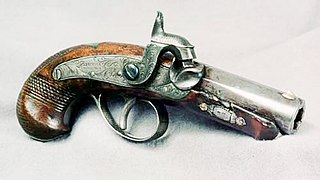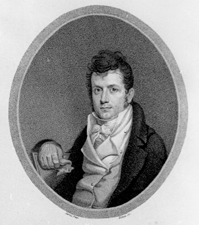
The long rifle, also known as the Kentucky rifle, Pennsylvania rifle, or American long rifle, is a muzzle-loading firearm used for hunting and warfare. It was one of the first commonly-used rifles. The American rifle was characterized by a very long barrel of relatively small caliber, uncommon in European rifles of the period.

A gunsmith is a person who repairs, modifies, designs, or builds guns. The occupation differs from an armorer, who usually replaces only worn parts in standard firearms. Gunsmiths do modifications and changes to a firearm that may require a very high level of craftsmanship, requiring the skills of a top-level machinist, a very skilled woodworker, and even an engineer. Gunsmiths perform factory-level repairs and renovations to restore well-used or deteriorated firearms to new condition. They may make alterations to adapt sporting guns to better fit the individual shooter that may require extensive modifications to the firearm's stocks and metal parts. Repairs and redesigns may require fabrication and fitting of unavailable parts and assemblies constructed by smiths themselves. Gunsmiths may also renew metal finishes or apply decorative carvings or engravings to guns. Many gun shops offer gunsmithing service on the premises.

Henry Deringer was an American gunsmith. He is best known for inventing and giving his name to the derringer pistol.
William Henry Ashley was an American miner, land speculator, manufacturer, territorial militia general, politician, frontiersman, fur trader, entrepreneur and hunter. Ashley was best known for being the co-owner with Andrew Henry of the highly-successful Rocky Mountain Fur Incorporated, otherwise known as "Ashley's Hundred" for the famous mountain men working for the firm from 1822 to 1834.

Alexander Contee Hanson was an American lawyer, publisher, and statesman. He represented the third district of Maryland in the U.S. House, and the state of Maryland in the U.S. Senate.
William Tranter was a British gunmaker and gun designer famous for inventing the Tranter revolver.

Jonathan Browning was an American inventor and gunsmith.
The surname Hawken comes from the Nordic given name Haakon, the name of seven Norwegian kings. The given name evolved to Hakon, and variations include: Håkon, Haakon, Horken, Hörken, Hawkin, Hawkins, and Hawken. Hawken is a possible variation of the English language surname "Hawkins".
Chouteau was the name of a highly-successful ethnically-French furtrading family based in Saint Louis, Missouri, which they helped found.

The Hawken rifle is a muzzle-loading rifle that was widely used on the prairies and in the Rocky Mountains of the United States during the early frontier days. Developed in the 1820s, it became synonymous with the "plains rifle", the buffalo gun, and a trade rifle for fur trappers, traders, clerks, and hunters. It was displaced after the American Civil War by breechloaders and lever action rifles.
The Fendall family was a prominent American political family that had its beginnings when Englishman Josias Fendall immigrated to the Province of Maryland in the early 1650s. He was appointed as the fourth proprietary governor of Maryland from 1656 to 1660.
The Fendall-Dent-Worthington family is a family of politicians from the United States. Below is a list of members:
Horace E. Dimick was a gunsmith and firearms dealer active in St. Louis, Missouri from 1849 through the early 1870s. Dimick expanded from a small custom gun store, to a larger emporium selling a variety of firearms and even manufacturing cannons. Dimick was respected for the quality of his firearms, but especially well known for his percussion rifles, especially his highly accurate plains rifles. During the Civil War, Dimick became nationally famous for providing the rifles for the elite sharpshooters of the 66th Illinois Volunteer Infantry Regiment.

The 1792 contract rifle is not a specific model of gun, rather it is a modern way to categorize a collection of rifles bought by the United States government in that year. United States 1792 contract rifles are Pennsylvania-Kentucky rifles with a 42-inch long octagonal barrel in .49 caliber, with a patch box built into the buttstock. What distinguishes them from civilian rifles is that they were bought by the government under military contract.

Christopher Hughes was an American attorney and diplomat who served as Chargé d'affaires in Sweden and The Netherlands in the 1820s and 1830s. He was the son in law of United States Senator Samuel Smith.

The Hamiltons of the United States are a family of Scottish origin, whose most prominent member was Alexander Hamilton (1755/57–1804), one of the Founding Fathers of the United States. Their ancestors and relations in Scotland included the Lairds of Kerelaw Castle in Stevenston, North Ayrshire, of the Cambuskeith branch of Clan Hamilton.









